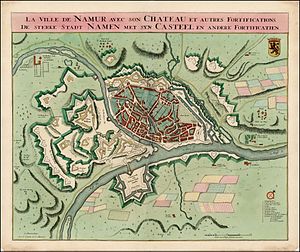Siege of Namur (1746)
| date | September 6th to September 30th, 1746 |
|---|---|
| place | Namur |
| output | French victory |
| Parties to the conflict | |
|---|---|
| Commander | |
|
General Crommelin |
|
| Troop strength | |
| 10,000 men | 7,000 |
| losses | |
|
? |
? |
The siege of Namur took place during the War of the Austrian Succession from September 6 to 30, 1746.
This was not a real siege, as the French were unable to properly enclose the city and citadel. Instead, they were prepared for a direct storm from the start.
France, Prussia, Spain and Bavaria had allied themselves to fight Austria in the German lands and also in Italy. The Netherlands , which were initially not affected, were drawn in when Louis XV. expanded the war by invading 100,000 men under the Maréchal de Saxe in the Austrian Netherlands in 1745 . The following year, the French captured Charleroi and then turned against Namur in the first days of September under the command of Louis de Bourbon-Condé, comte de Clermont .
The fortress garrison consisted of twelve Dutch and two Austrian battalions - a total of 7,000 men. They were under the command of Count von Colyar, who, due to his old age and health problems, left the fortress on September 13th and transferred the command to General Crommelin.
The city itself was attacked at the Porte de Saint-Nicolas. The French established two batteries opposite the forward forts of Saint-Antoine and Espinois. A few days later, on the night of September 11th, work on the siege trenches began. By this time, more than 400 Dutch had defected to the French.
On the night of September 18-19, the besiegers had already seized the outer works, only Fort Coquelet and the Jambes bridgehead were still in the hands of the besieged. At daybreak the crew left Fort Jambes and blew up three arches of the bridge over the Meuse behind them .
At 7:00 a.m. Fort Coquelet surrendered, and at 11:00 a.m. the city followed.
The French now began the attack on the actual fortress above the city, where the remaining garrison (further desertions had taken place) had withdrawn. Batteries with siege guns were placed opposite the citadel , the Terre Neuve suburb and Fort Orange (called Fort Willjam on the map). Fire opened on the afternoon of September 24th. A grenade detonated the powder magazine, destroying numerous buildings, including the Saint-Pierre church.
Meanwhile the artillery had breached the ramparts of Fort Orange and the citadel, and preparations were being made for the attack. The besieged then hoisted the white flag at 6:00 p.m. on September 30th.
The garrison was taken prisoner of war. On October 4th, the Provincial Council and the Magistrate were placed under French administration.
With the Treaty of Aachen , the Austrian Netherlands returned to Austria in 1748. The French occupation left the fortress on February 10, 1749.
literature
- Jules Borgnet: Promenades dans Namur. A. Wesmael-Legros, Namur 1859, p. 49.
Web links
- Namur - des sièges. In: Histoire de la Meuse wallonne
